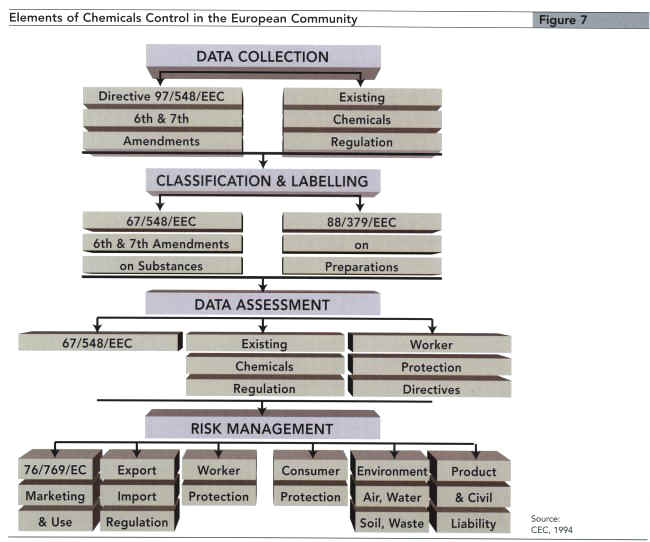6 Some policy initiatives for
reducing risk
There are over a dozen European Union Directives on
chemicals control (Fig. 7) concerning classification and labelling, marketing and use,
risk assessment, and protection of workers, consumers and the environment. Compliance
with, and enforcement of these Directives is uneven, in part because it can be difficult
for industry to know how best to achieve compliance with several sets of regulations. For
example, in the dyestuffs industry, a highly competitive business involving many
innovative and potentially hazardous chemicals, a study of the Notification of New
Substances Directive (the NONS project, VROM 1996) in the 15 Member States of the EU found
that many new substances being used had not been reported to the regulatory authorities,
or even identified. Their use was not properly recorded, and in some cases they were
inadequately labelled. About 45% of the 96 companies visited in most countries of the EU
did not conform to this Directive. However, a follow-up project revealed some
improvements, with just 32% of the 100 companies inspected in this sector not conforming
to the Directive (the SENSE project; VROM, 1998).

All European countries have extensive national legislation in
the field of chemicals. For example, a review of UK legislation on the control of
chemicals (excluding pharmaceuticals and poisons) listed 25 relevant Acts of Parliament
which were overseen by seven government departments and augmented by over 50 sets of
regulations (Haigh, 1995). A similar pat-tern of multi-departmental policy response exists
in many EU countries, which is prompting efforts to streamline such legislation and to
shift the focus of policy measures from "downstream" impacts of control on
workplaces, consumers and ecosystems to "upstream" reduction of exposure
potential and prevention (Gottlieb, 1995; Steingraber, 1997) (Fig. 6). The Integrated
Pollution Prevention and Control Directive of the EU obliges large plants to adopt such a
comprehensive approach to pollution prevention.
In addition to EU Directives and regional initiatives, European
countries are guided by a number of regional and international treaties. The Convention
on Long-Range Transboundary Air Pollution (LRTAP), adopted in 1979 under the
auspices of the United Nations Economic Commission for Europe (UNECE), covers Europe and
North America. This Convention includes measures for eliminating or restricting use,
reducing consumption and unintentional emissions or contamination, eliminating waste and
improving the management of chemicals. It features two new protocols signed at the
pan-European Ministerial meeting at Aarhus in June 1998. One protocol covers Persistent
Organic Pollutants (POPs), including 16 pollutants: aldrin, chlordane, chlordecone, DDT,
dieldrin, dioxins, endrin, furans, heptachlor, hexa-bromobiphenyl, hexachlorobenzene,
hexa-chlorocyclohexane (including the isomer Lindane), mirex, polycyclic aromatic
hy-drocarbons, PCBs and toxaphene. The other protocol covers certain heavy metals
(cadmium, lead and mercury).

The Chemical Industry Sustainable Economic and Ecological
Development programme (CHEMISEED), managed by the United Nations Economic
Commission for Europe (UNECE), focuses mainly on harmonising legislation, cleaning
contaminated sites, and promoting the eco-efficient use of chemicals in Central and
Eastern Europe. The UNECE Working Group on Abatement Technology is helping countries to
comply with the 1991 Volatile Organic Compounds (VOC) Protocol, under the LRTAP
Convention, which came into force in 1997.
The voluntary Prior Informed Consent (PIC) procedure
has been developed by UNEP and the Food and Agriculture Organization (FAO) of the United
Nations. In March 1998, governments completed negotiations to transform PIC into a legally
binding convention for strengthening the management of certain hazardous chemicals in
international trade. Under PIC, governments will be required to stop the export of listed
chemicals to other countries that have indicated that they do not want them imported,
provided the importer does not manufacture or import the substance from another source for
domestic use. Thus, chemicals can be pre-vented from entering countries where the risks
they pose are deemed unacceptable by the recipient country. Soon after completing PIC,
governments began negotiations (June 1998) on a global convention dealing with
persistent organic pollutants (POPs). Its purpose will be to reduce and/or
eliminate the release into the environment of those POPs which pose significant threats to
human health and wildlife. Although the convention negotiations are to focus initially on
a list of 12 POPs, they will include the development of criteria and a process for
identifying additional POPs for international action. These negotiations under the
auspices of UNEP are to be completed by the year 2000.
Co-ordination of international work on chemicals has been
facilitated by the IFCS which was established in 1994 as called for in Chapter 19 of
Agenda 21 of the 1992 UN Conference on Environment and Development. The IFCS provides
policy guidance and strategies for implementation of the major programme areas contained
in this chapter, including harmonisation of risk assessments and chemical classification,
information exchange, risk reduction and chemicals management capacity building.



Document Actions
Share with others